#mesozoic landscape
Text

In the morning rain
#art#artists on tumblr#dinosaurs#paleoart#paleontology#coelophysis#triassic#mesozoic#digital art#artwork#landscape#forest#rainymood#my art#artistsupport#small artist#dinoart#paleoblr#paleoillustration#paleobiology
2K notes
·
View notes
Text
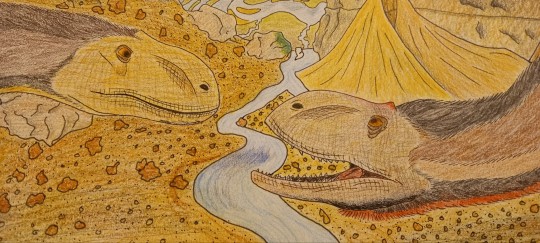



Rajasaurus narmadensis
Rajasaurus is an Indian dinosaur from the late Cretaceous Period 72-66 million years ago.
Probably didn't have feathers, I just felt like adding them.
#palaeoart#art#dinosaurs#mesozoic#paleontology#theropod#cretaceous period#Indian dinosaurs#landscapes#watercolour pencils
22 notes
·
View notes
Text
Walking in the Chinle Formation
Welcome to Arizona in the Triassic Period. Walking in Chinle Formation.

View On WordPress
#adobe photoshop#arizona#artistatwork#Commissions Open#Concept Art#Desmatosuchus#Digital Art#Digital Painting#DigitalPainting#dinosaur#Environment Design#forrest#landscape#landscape art#Mesozoic#national park#Native American#paleo art#paleontology#petrified forrest park#Placarias#Postosuchus#Pueblo#Pueblo People#Triassic#Triassic Period#Wacom Tablet
17 notes
·
View notes
Text
the prairie and the sea...

View On WordPress
#@capecodlife#@CAPECODPHOTOS#@southdakota#@southdakotagram#@southdakotaphotography#ancestors#ancestory#Cape Cod#henrydavidthoreau#homesteading#landscape#mesozoic#middle age#ocean#paleozoic#Photography#prairie#sea
1 note
·
View note
Text
ITS ALMOST FOSSIL NOVEMBIRB!!!!!
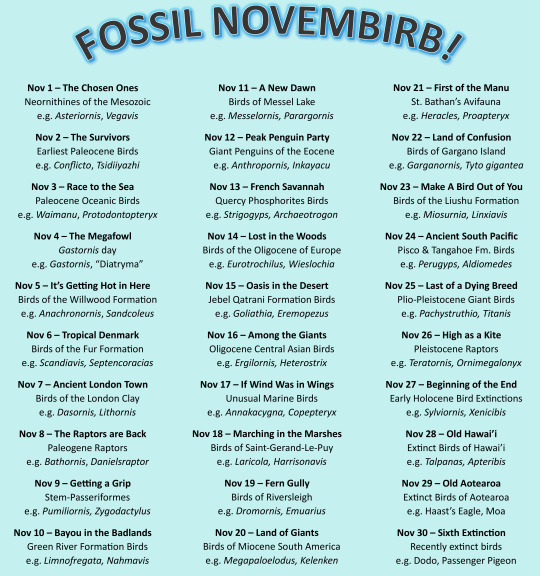
We're going to have a CELEBRATION of FOSSIL NEORNITHINES for this November!!! The extinct members of the only group of dinosaurs we have today!
Each day will have a prompt inspired by the evolution of crown-birds and the amazing forms they have taken over the past 68 million years!
You can respond to each day's prompt however you wish - with drawing and painting, writing, sculpting, music, videos, whatever! Just tag it "#Fossil Novembirb" for me to find it, and it'll get reblogged!
I'm so excited to see the art you guys create!
NOVEMBER 1 - THE CHOSEN ONES
Crown-Birds (Neornithes) known from the Mesozoic Era!
Options include Asteriornis, Teviornis, Vegavis, and "Styginetta"!
These are the only dinosaurs that survived the asteroid!
Theoretically there were also early Palaeognaths and Neoavians - if you want to do some spec evo and hypothesize what you think they might have looked like, go ahead! Follow your dreams!
NOVEMBER 2 - THE SURVIVORS
The earliest birds known after the K-Pg boundary!
Options include Conflicto, Tsidiiyazhi, Australornis, Qinornis, and Qianshanornis!
Birds diverged rapidly after the extinction, so also feel free to dive into spec evo into some of the forms we don't have fossils of!
NOVEMBER 3 - RACE TO THE SEA
The first Marine Neornithines and how they evolved in the early Paleocene!
Includes tons of early penguins like Waimanu, Kumimanu, Sequiwaimanu, Muriwaimanu, and Kupoupou
Also includes the first Pseudo-toothed bird, Protodontopteryx, and the earliest known Tropicbird, Clymenoptilon!
RISE OF THE PENGUINS!
NOVEMBER 4 - THE MEGAFOWL
Gastornis (aka "Diatryma", aka "Zhongyuanus") appeared in the mid-Paleocene and was a feature of the Cenozoic landscape until the end of the Eocene - so we have a whole day JUST FOR IT
Show your love for the Megafowl Gastornis! This giant herbivorous bird was fascinating, and has captured imaginations for decades because of it!
Gastornis is also present in many of the ecosystems described below, such as Willwood, Green River, and Messel, so we also just wanted to make sure people didn't keep picking Gastornis over and over again xD
NOVEMBER 5 - IT'S GETTING HOT IN HERE
The Paleocene-Eocene Thermal Maximum was the most dramatic incident of rapid global warming in the world since the Permian... until today!
It majorly affected the evolution of many things, possibly including birds!
The Willwood Formation straddles the time period of the warming, and has tons of birds that were evolving during that time period! So, for this day, create things involving birds of the Willwood Formation!
Options include the flighted Palaeognaths Lithornis promiscuus and Lithornis plebius; the possible stem-Ostrich Paragrus, the early half-screamer-half-duck Anachronornis, the early owl Primoptynx, and the fascinating stem-mousebird Sandcoleus! And many more!
NOVEMBER 6 - TROPICAL DENMARK
Birds of the Fur Formation, one of the best collections of bird fossils from the early Eocene!
Includes such friends as Scandiavis (an early shorebird), Septencoracias (an early roller), Pellornis (an early rail-esque thing), the utterly mysterious Morsoravis, and the early swift-hummingbird Eocypselus!
This was a tropical shoreline environment with many of the first members of major bird groups we see today!
NOVEMBER 7 - ANCIENT LONDON TOWN
Across the shore from Fur was the London Clay Formation, a lush tropical forest near the warm shallow ocean
In addition to a truly alarming quantity of plant fossils, this is a notable locality for early birds, featuring many early members of major groups much like the Fur Formation
Options include Dasornis (a pseudotoothed bird), Pulchrapollia (one of the Parrot-Passerines of Prey), Nettapterornis (another stem-duck), Nasidytes (an early loon), Charadriisimilis (an early shorebird), Archaeodromus (a trogon-like member of Strisores), Eotrogon (an actual early Trogon), Lithornis vulturinus (another flighted Palaeognath), Prophaethon (another early Tropicbird), and Ypresiglaux (an early owl) - and so many more!
NOVEMBER 8 - THE RAPTORS ARE BACK
Turns out "Predatory Feathered Thing with Really Sharp Foot Claws" is a very successful niche - not only was there potentially one right after the end of the Cretaceous (Qianshanornis), but other raptors were some of the first birds to succeed around the world in the Eocene
So this day is dedicated to the early raptors of the Cenozoic!
Any "raptor" from the Paleogene is valid - so here are some suggestions:
Early Cariamiformes (Seriemas and Kin) like Bathornis, Dynamopterus, Strigogyps, and the first potential Terror Birds like Paleopsilopterus
Early Owls like Ypresiglaux and Palaeoglaux
Early Accipitriformes like Horusornis
Early Falcons like Antarctoboenus, Masillaraptor, and Danielsraptor
And of course the ever popular "Parrot-Passerines of Prey" like Tynskya and Messelastur
NOVEMBER 9 - GETTING A GRIP
Half of all living birds are Passeriformes - aka "Perching Birds" - but this wasn't always the case! For most of Earth's history, many other kinds of tree birds were extremely common
Where did this behemoth group of tiny dinosaurs come from? That's the subject of this day's prompt!
In the Eocene, the first birds closer to Passeriformes than to Parrots evolved, and they came in a huge variety of forms! So on Nov 9th, we're going to celebrate this group's interesting beginnings!
Options for this include Parapsittacopes, Eofringillirostrum, Pumiliornis, Psittacopes, Zygodactylus, Primozygodactylus, Psittacomimus, Sororavis, Morsoravis, and Eozygodactylus! Go wild!
NOVEMBER 10 - BAYOU IN THE BADLANDS
Back to specific ecosystems! We're visiting the world-famous Fossil Lake of the Green River Formation!
This environment, during the Early Eocene, was a thriving tropical lake and forest ecosystem filled with tons of early Neornithines as well as mammals and other animals
Gorgeous fossils have come out of this lake, showing truly amazing detail of feathers and other features for these birds!
So here you can feature Prefica (a potential early Oilbird), the flighted Palaeognath Calciavis, the stem-turaco Foro, the early mousebird Celericolius, the possible shore-bird Nahmavis, a potential cuckoo roller Plesiocathartes, the Flamingo-Duck Presbyornis, the early landfowl Gallinuloides, the swift-hummingbird Eocypselus, and the Frigate Bird Trying at being a Gull Limnofregata - and so many more!
NOVEMBER 11 - A NEW DAWN
We're finally moving on to the middle Eocene - and the Messel Lake ecosystem, famous from the first episode of Walking with Beasts (hence the name of the day)!
(If you're going "wait, that episode acts like nothing happened between the K-Pg and Messel, but here you have 10 days worth of stuff" .... yeah. Walking With Beasts skipped the Paleocene and early Eocene and I am... very pissed. Still.)
You know about the tons of early mammals from this tropical lake ecosystem, but it was filled with tons of early birds as well!
There's the early ostrich Palaeotis, the crane-rail Messelornis, the almost-flamingo Juncitarsus, the freshwater Booby Masillastega, the early hoopoe Messelirrisor, Selmes (a mouse bird with stubby toes), the early ibis Rhynchaeites, the early nightbird Hassiavis, the early swift Scaniacypselus, an early roller with known colors Eocoracias, and the early potoo Paraprefica - and many others!
NOVEMBER 12 - PEAK PENGUIN PARTY
As the Eocene continued, penguins achieved true megafaunal status - there were tons of them, they were huge, and they were all over the oceans of the Southern Hemisphere
While penguin diversity never did recover after the Eocene-Oligocene extinction event, this golden age deserves celebration!
Some of these fascinating peak penguins include Palaeeudyptes, Anthropornis, Icadyptes, Inkayacu, Perudyptes, and Kairuku!
NOVEMBER 13 - FRENCH SAVANNAH
As the Eocene began to dry up and cool down, plains grew across the world where the tropical forests once had been
One of the most famous later-Eocene fossil sites for birds is the Quercy Phosphorites location, a French formation with tons of interesting fossil birds!
Here we start to see the early forms of Neornithine Dinosaurs we saw in the Paleocene-Early Eocene diverge and specialize further - often in particularly weird or interesting ways!
So here we have the duck-ish chicken Paraortyx, the secretarybird Pelargopappus, you can also bring back Dynamopterus from earlier, there is the stem-chicken Quercymegapodius as well as stem-parrots like Quercypsitta, the seriema-like Strigogyps, the sandgrouse relative Archaeoganga, Archaeotrogon shows up again, the swift relative Aegialornis, a potential woodpecker relative Sylphornis, and more owls like Palaeoglaux! Lots of cursorial predators in this ecosystem!
NOVEMBER 14 - LOST IN THE WOODS
As the Oligocene dawned, forests did grow back in Europe, though they were now temperate and dry as opposed to the paratropical rainforests of before
This lead to wide diversification of tree-dwelling birds, and so here we will celebrate the birds of the Oligocene of Europe!
We start to really see modern-esque birds at this point, though of course we still have 30 million years of evolution to go!
Here you can feature the early eagle/hawk Aviraptor, the European Hummingbird Eurotrochilus, the seabird relative Rupelornis, the early woodpecker-toucan Rupelramphastoides, the tody Palaeotodus, the proper Passerine Wieslochia, the possible shorebird Turnipax, the mousebird Oligocolius, the hoopoe Laurillardia, and the trogon Primotrogon which we know the colors of!
NOVEMBER 15 - OASIS IN THE DESERT
The Jebel Qatrani Formation of Egypt shows the beginnings of the famous African Grassland animals, as well as many early members of iconic African animal groups such as primates - and, of course, birds!
Taking place in the early Oligocene, this formation was a tropical/subtropical lowland plain filled with ponds and streams and other waterways - aka, tons of swamps surrounded by plains
As such, this place is infested with waterbirds!
Here we have a fossil relative of the Shoebill Goliathia, as well as the jacanas Janipes and Nupharanassa, the giant stork Palaeoephippiorhynchus, the herons Nycticorax and Xenerodiops, and the mystery Palaeognath Eremopezus!
NOVEMBER 16 - AMONG THE GIANTS
Once again we're just fully committing to the Walking With Beasts nostalgia bc these are the birds we wish were in it more okay we said it
Anyways there were some interesting large birds in the plains of the "Land of Giants" episode so picture these guys alongside the Indricothere etc.
In general we're covering the latest Eocene through the Oligocene of Central Asia
Here we have the enigmatic ratites Ergilornis and Sonogrus, the pseudo-toothed bird Caspiodontornis, the owl Heterostrix, and the stem-flamingo Agnopterus
NOVEMBER 17 - IF THE WIND WAS IN OUR WINGS
We all focus on penguins, but over the Cenozoic, plenty of weird birds have evolved for marine life, and boy are they bizarre!
So for Nov 17, we're focusing on the unusual marine birds of the Cenozoic!
This includes any members of the Pelagornithids - aka the Pseudo-toothed birds - as well as the Plotopterids - the Boobies that became Penguins! Pelagornis and Copepteryx are the best known taxa from each, respectively, but there are plenty more!
But that's not all! We have the flightless auks Miomancalla and Mancalla, the large flightless marine duck Chendytes, and who can forget the weird flightless marine swan Annakacygna! Tons of options to choose from!
NOVEMBER 18 - MARCHING IN THE MARSHES
We're now starting our transition from the Paleogene into the Neogene, beginning with the brackish marsh ecosystem preserved at Saint-Gerand-Le-Puy in France!
This Miocene locality preserves a wide variety of birds that are near modern, but not quite - a sort of "uncanny valley" of bird evolution, all set in a somewhat-salty somewhat-not wetland ecosystem
Options for dinosaurs here include Harrisonavis, a transitional flamingo; the early gull/tern Laricola, the enigmatic duck Mionetta, the stork Grallavis, the pratincole Becassius, the swimming-flamingo Palaelodus, the early cormorant Nectornis, the seed-eating pheasant Palaeortyx, the early loon Colymboides, and the mysterious shorebird Elorius!
NOVEMBER 19 - FERN GULLY
Riversleigh is one of the most famous fossil sites in the world, preserving the evolution of the strange and unique animals known today in Australia, during the Oligocene to Miocene transition
Most often, we focus on the bizarre mammals found at Riversleigh, and for good reason - it's a Marsupial Party! - but the birds here are fantastic as well
This ecosystem was a rich rainforest that transitioned over the period of deposition into a semiarid grassland, and covers 20 million years of animal evolution during that transition
Options for birds here include the butcherbird Kurrartapu, the fossil Sittella Daphoenositta trevorworthyi, the Mihirungs ("Demon Ducks") Dromornis and Barawertornis, the Emuwary Emuarius, the early magpie-goose Eoanseranas, the raptor Pengana with flexible ankles, the earliest known species of lyrebird (Menura tyawanoides), the corvid-like Corvitalusoides, the first known cockatoos, the flightless rail-like bird Australlus, the stiff-tailed duck Pinpanetta, the early logrunner Orthonyx kaldowinyeri, and so many more!
NOVEMBER 20 - LAND OF GIANTS
Y'all were probably wondering when we'd get to the Terror Birds and other interesting dinosaurs of South America, so - here we are!
South America, isolated from the rest of the world until the Great American Interchange, featured a wide variety of bizarre and unique animals - not just mammals, but birds and other reptiles as well!
So for Nov 20th, we're looking at the interesting dinosaurs of the "lost continent" during the Miocene epoch, prior to the invasion of North American taxa!
Any Miocene South American Terror Bird (Phorusrachid) is fair game here, so that includes Brontornis, Patagorhacos, Paraphysornis, Devincenzia, Kelenken, Phorusrhacos, Patagornis, Andalgalornis, Psilopterus, Mesembriornis, and Procariama! Note that they did not all live at the same time or even close to each other in location, so do your research on the taxa you pick!
But Terror Birds weren't the only strange dinosaurs in South America at the time! We have the large Teratorn (vulture-like-thing) Argentavis, the *giant* swimming-flamingo Megapaloelodus, the giant Anhinga Macranhinga, the rhea Opisthodactylus, the penguins Palaeospheniscus, Arthrodytes, and Paraptenodytes, the Cathartid Dryornis, the Jacamar Galbula hylochoreutes, fossil Hoatzins like Hoazinavis and Hoazinoides, the giant stork Leptoptilos patagonicus, and the owl Yarquen!
NOVEMBER 21 - FIRST OF THE MANU
Aotearoa has one of the most unique avifaunas in the world today, and I often call it "Mesozoic 2" because of its almost entirely dinosaur-dominated fauna, especially in the past
All great things have to start somewhere or when, and for Aotearoa, that somewhen was after the landmass resurfaced from the ocean for the first time in millions of years - and was quickly inhabited by all kinds of birds and other reptiles (including tuatara) in the Miocene
This ecosystem was a lake bordered by grassy wetland floodplains and subtropical forests, a bit warmer than Aotearoa today
Dinosaurs here include the early Kiwi Proapteryx, an unnamed early Moa, a truly alarming number of waterfowl including shelducks like Miotadorna, stiff-tailed ducks like Manuherikia, and the possible swan Notochen, the small swimming-flamingo Palaelodus aotearoa, pigeons like Rupephaps and Deliaphaps, an early adzebill Aptornis proasciarostratus, flightless rails like Priscaweka, the lake-wanderer Hakawai melvillei, the herons Pikaihao and Matuku, the giant parrot Heracles, proto-keas Nelepsittacus, and the New Zealand Wren Kuiornis. Tons of fun species to choose from!
NOVEMBER 22 - LAND OF CONFUSION
In the Late Miocene to Early Pliocene, the Italian province of Gargano was cut off from the mainland due to rising sea levels, turning it into an island - an island with lots of really strange birds!
This island was cut off from everything else and completely lacked large predators, allowing for a weird variety of animals to evolve and thrive prior to the island rejoining the mainland during the Ice Age
Strange birds of this ecosystem include the extremely old pigeon Columba omnisanctorum, the giant hawk Garganoaetus, the giant flightless goose Garganornis, the giant barn owl Tyto gigantea, the pheasant Palaeortyx volans, and the swift Apus wetmorei!
NOVEMBER 23 - MAKE A BIRD OUT OF YOU
The iconic animals of the Ice Age and recent prehistory had to come from somewhere, and much of this transition is recorded in the Chinese Ecosystem of the Liushu Formation, deposited between 11 and 6.4 million years ago
As grasslands expanded, this ecosystem transitioned from a forest to a wide plains, and many animals adapted for the grasslands accordingly, leading to the appearance of such mammals as Elasmotheriines, Sabercats, Hyenas, Ambelodonts, and a truly alarming quantity of hoofed mammals
Dinosaurs (Birds) adapted to this ecosystem change as well, of course! While most focus on the mammals of Liushu, we're here to showcase the interesting birds that appeared here as well!
Options here include the the very well preserved Falcon Falco hezhengensis, the vultures Mioneophron and Gansugyps, the diurnal owl Miosurnia, the vocally fancy pheasant Panraogallus, the sandgrouse Linxiavis, the Ostrich Struthio (or Orientornis) linxiaensis, and the probable-Ostrich Sinoergilornis
NOVEMBER 24 - ANCIENT SOUTH PACIFIC
Penguins are Bouncing Back! As the Miocene continued and the Pliocene began, many new types of marine birds showed up and were fossilized in locations in Chile (Pisco) and Aotearoa (Tangahoe)
Tons of interesting birds were preserved in this sort of transitional ecosystem, showcasing how birds adapted to changing conditions as the Miocene-Pliocene climatic turmoil continued
These near shore environments are probably more famous for their other animals - things like the giant shark "megalodon", as well as weird whales like Livyatan and Odobenocetops and aquatic giant sloths (like Thalassocnus) and marine crocodilians - but we're here for those dinosaurs!
Options here from the Pisco Formation include the "Toucan-Booby" Ramphastosula, the Cathartid Perugyps, the Booby Sula figueroae, Pelagornithids, Pelicans, and the penguins Spheniscus urbinai and Spheniscus megaramphus, whereas birds from the Tangahoe Formation include the narrow-beaked albatross Aldiomedes, the giant petrel Macronectes, the more regular-sized petrel Procellaria altirostris, the little penguin Eudyptula wilsonae, and the crested penguin Eudyptes atatu!
NOVEMBER 25 - LAST OF A DYING BREED
We all love Megafuana, even though they are usually the "Live Fast Die Young" kind of species - gobbling up resources and growing too big will do that to you
Usually when we hear the term "Megafauna" we think of Mammals and Non-Avian Dinosaurs, but birds have had their share too - and have lost their share as well
So, mainly to cater to the Megafauna Fanbase, here we dedicate a whole day to the giant birds of recent times - Pliocene through Pleistocene - that we have lost to the dramatic climate change of the Ice Age Era. (Those lost in the Holocene will get their own days, see below)
Options for this day include the giant ostrich Pachystruthio, the Mihirung Genyornis, the Terror Bird Titanis, the giant stork Leptoptilos robustus, the giant swan Cygnus falconeri, the giant Anhinga Giganhinga, and of course - we can't forget our friend - the last of the Pseudotoothed Birds, Pelagornis
NOVEMBER 26 - HIGH AS A KITE
In many ways, the real dinosaur winners of the Ice Age were the flying Birds of Prey, as there were many kinds of raptors during the Ice Age and they exploited the new environment expertly
Nothing like being able to traverse huge distances to find places where there are food, amiright?
So this day is dedicated to the fantastic Raptors of the Ice Age, both volant and not!
Here we have some of the last of the Teratorns like Teratornis itself, the Giant Australian Raptor Dynatoaetus, the Australian Vulture Cryptogyps, Woodward's Eagle Buteogallus woodwardi, the tiny Condor Wingegyps, the large Cuban Eagle Gigantohierax, the wandering vulture Neogyps, the Walking Eagle Buteogallus daggetti, the Giant Cuban Stilt-Owl Ornimegalonyx, and one of the last Terror Birds, Psilopterus
NOVEMBER 27 - BEGINNING OF THE END
Oh Holocene Extinctions. As upsetting as they are, they include some of the best known fossil/subfossil birds, so we decided to spend a little extra time on them than they should have based solely on the time length
Here, we highlight the early losses of the Holocene - those dinosaurs that went extinct at the start, largely due to direct human activity such as hunting in addition to the warming caused by the end of the last Ice Age/Glacial Maximum
Days will be dedicated to both Hawai'i (see below) and Aotearoa (again, below), so this is for everyone else!
So options here include the previously mentioned marine duck Chendytes, the giant flightless landfowl Sylviornis from New Caledonia, the famous Elephant Birds of Madagascar, the flightless clubbing-ibis Xenicibis, the weird puffin Fratercula dowi, the giant Bahama Eagle Titanohierax, the Californian Turkey Meleagris californica, and the flightless "Cave Rail" Nesotrochis of the Greater Antilles
NOVEMBER 28 - OLD HAWAI'I
Many, many, MANY unique dinosaurs live on islands. The islands of Hawai'i are no exception, and these islands have lost many unique and fascinating birds over the years - thanks to human activity, invasive cats, colonialism, and climate change
We couldn't possibly ignore them, so for this day, we are hilghlighting these amazing animals found across the archipelago
There are tons of options, but some of our recommendations include the reverse-platypus/Mole Duck Talpanas, the Stilt-Owl Grallistrix, the flightless ibis Apteribis, the Moa-Nalo like Chelychelynechen, Ptaiochen, and Thambetochen, the Wood Harrier Circus dossenus, Hawai'ian Honeycreepers like Drepanis, Aidemedia, Hemignathus, Chloridops, Akialoa, Rhodacanthis, Dysmorodrepanis, Telespiza, and Vangulifer, the Oloma'o and ʻĀmaui thrushes, ʻōʻō's/Hawai'ian Honeyeaters like the Kioea, Kauaʻi ʻōʻō, and Oʻahu ʻōʻō, the giant Hawai'i Goose, the nēnē-nui/wood-walking goose, the Robust Crow, the flightless Laysan Rail, and the O'ahu Petrel
NOVEMBER 29 - OLD AOTEAROA
We're finally here: Pre-Human Holocene Aotearoa, aka Mesozoic 2, aka The Land Where Mammals Ain't Shit
I love Aotearoa so much. Why wasn't I born there. The universe isn't fair.
The ecosystems were very similar to today - podocarp forests and southern beech forests, grass and tussock plains and shrublands, and plenty of coastal habitats, all usually temperate in terms of climate
All named Moa are fair game. All of them, all named members of Dinornithiformes. So the North Island Giant Moa, the South Island Giant Moa, the Bush Moa, the Eastern Moa, the Broad-Billed Moa, the Heavy-Footed Moa, Mantell's Moa, the Crested Moa, and the Upload Moa. Follow your Moa-Filled Dreams!
Obviously there were more than Moa - not just the living species of Aotearoa still with us, but tons of other extinct forms for Fossil Novembirb. This includes the Adzebills, Haast's Eagle (of course), the whēkau/Laughing Owl Ninox albifacies, the New Zealand Goose Cnemiornis, the New Zealand Owlet-Nightjar, the mehonui Diaphorapteryx, the Long-Billed Wren Dendroscansor, the piopio Turnagra, and the Huia
NOVEMBER 30 - SIXTH EXTINCTION
And, for our last day, we cover recent Holocene extinctions (not on Hawai'i or Aotearoa) - the birds/dinosaurs we have lost in the living past, due largely to colonialism, capitalism, globalism, and climate change
Any bird extinct since 1492 not previously covered is fair game, and there are a lot of them. Today, we honor them, however we can.
Some suggestions include the Dodo (of course), the Cuban Macaw, the Pink-Headed Duck, the Northern Curlew, the Great Auk, the Passenger Pigeon, the Carolina Parakeet, the Ivory-Billed Woodpecker, the Labrador Duck, the Saint Helena Hoopoe, and the Spectacled Cormorant; though there are of course many otherse to choose from as well
Kind of a bummer note to end on, but here we are
Living Birds already get tons of time and attention, so we really don't want to include them here - we love them, but the fossils of the Neornithes world deserve love too! So we tried to cover all of the bases, as best as we could!
Remember, Wikipedia, the Paleobiology Database, The Works of Gerald Mayr, the third volume of "Earth Before Us", and the blogs of myself and @albertonykus and @otussketching are all fantastic resources to look for information about these wonderful animals! Also check out Through Time and Clades' "Dinosaurs: The Second Chapter" series and the Raptormaniacs blog from Albert as well!
HAVE FUN! CREATE WHAT YOU DREAM! AND LOVE CENOZOIC DINOSAURS!
HAPPY FOSSIL NOVEMBIRB!
#Fossil Novembirb#Novembirb#Dinovember#birblr#palaeoblr#Birds#Dinosaurs#Cenozoic Birds#Neornithines#Dinovembirb
613 notes
·
View notes
Text

Now, scientists have confirmed that 107-million-year-old fossils found in Victoria are the oldest remains of pterosaurs that soared across the Australian landscape.
Pterosaurs were flying reptiles, that lived alongside their dinosaur cousins during the Mesozoic Era, which began 252 million years ago.
They were the first and largest vertebrates to fly — taking to the skies 65 million years before birds – and they lifted off using membranous wings that were more bat-like than bird-like.
Pterosaur fossils are very rare, especially in Australia.
That's why palaeontologists were excited when two tiny fossils were found embedded in a seaside cliff near Cape Otway, 220 kilometres south-west of Melbourne in the 1980s...
28 notes
·
View notes
Text
Island of the Skull - Map

This is a map I made in the program Wonderdraft that shows my personal take on the archetypal "Skull Island" as seen in various pirate- and adventure-themed media.
Unlike some other variations of the trope, my version is located deep within the equatorial Atlantic Ocean and owes its flora and fauna to migrations over the course of at least 150 million years. The island's most iconic megafauna are the dinosaurs and other descendants of Mesozoic migrants. However, later arrivals have managed to eke out their own niches beneath the giant saurians, including monkeys related to New World platyrrhines, gorillas and chimpanzees, elephants of African forest affinity, pantherine cats of mixed leopard and jaguar heritage, and even phorusrhacid "terror birds".
The island's human inhabitants would have arrived from the West African coast sometime before 2000 BC, bringing with them established traditions of agriculture and ferrous metallurgy that allowed them to colonize the treacherous landscape and carve it into numerous chiefdoms and states over the course of centuries. The most famous of these societies, the so-called "Kingdom of the Skull", developed in the rainforest on the windward side of the volcanic "Mountains of Hell", but fell into ruin at an uncertain date, although local traditions attribute its collapse to provoking the wrath of a deity known as the "Flaming Skull". Nonetheless, the islanders remain numerous across the island's breadth, maintaining a rich variety of distinctive cultures and dozens of different languages, albeit all sharing what may be a distant kinship with the Gbe languages of coastal West Africa.
It was in the late 1400s when Portuguese mariners first chanced upon the Island of the Skull and shared their knowledge with other Europeans. Nonetheless, both the mosasaur-haunted waters encircling the island and its own hostile terrain have discouraged large-scale European colonial expeditions, although some daring buccaneers and corsairs have nonetheless succeeded in establishing commerce with indigenous communities on the coast. Many of these swashbucklers covet the fabled riches of the ancient Kingdom of the Skull, but few who have penetrated its interior have come back to tell the tale…
And here's the (admittedly Google-translated) Portuguese version:
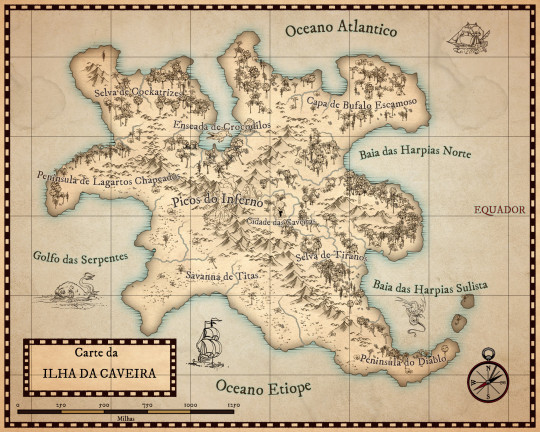
#Skull Island#Island of the Skull#pirate map#adventure#pirates#map#cartography#worldbuilding#lost world#Wonderdraft
10 notes
·
View notes
Text
New Post has been published on Books by Caroline Miller
New Post has been published on https://www.booksbycarolinemiller.com/musings/the-way-of-the-bear/
The Way Of The Bear

Anne Hillerman’s 8th book in her mystery series featuring Navajo detectives Leaphorn, Chee, and Manuelito is a page-turner. Taking it to bed thinking you’ll drop off to sleep is a mistake. Instead, you’ll find yourself reading until the morning’s light. Set in Utah’s Bear Ears National Monument territory, The Way of the Bear places husband and wife Navajo detectives Jim Chee and Bernadette Manuelito in mystical surroundings. Against a backdrop of Mesozoic Age artifacts and Indian tradition, they struggle to solve a series of modern crimes. Murder hadn’t been on their agenda as the pair headed from New Mexico to Utah. Chee’s assignment was to meet a paleontologist who wanted to make a sizeable donation to a Navajo police charity. Manuelito wanted a holiday, a consolation for having lost a job promotion. Neither is prepared to deal with the cast of thugs, thieves, and killers that await them. Nor could they have predicted that nature would summon a storm to block roads and cut off electronic devices as it dumped several feet of snow over the normally tawny landscape. After Bernadette’s phone goes dead during a worrisome conversation with her sister about their mother’s deepening dementia, the detective decides to leave her exploration of ancient cave paintings and return to New Mexico. As she drives to her hotel intending to pack, she notices a car by the side of the road seemingly mired in the snow. She stops to investigate and discovers the woman inside the vehicle is about to give birth. With medical help out of reach, Manuelito assists with the delivery. To her surprise, the baby’s first cry awakens maternal longings within her, emotions that confuse her thoughts about her future. Meanwhile, a security guard has driven Chee to his appointment with the paleontologist. Despite the storm, they arrive at the scientist’s home on time. What they find is a body slumped near the entrance and a door forced open by the blows of an axe. Entering the hose, they discover it is empty and the premise intact, except for traces of yellow powder in some of the rooms. Where is the scientist? And who murdered the man outside being buried in the snow? Chee is forced to investigate. As he plows through the evidence and interviews several suspects, he encounters more bodies, one of them his wife’s. She’s alive but she’s been hogtied and stuffed into the trunk of a suspicious car. Once released, she joins Chee’s hunt for the murderer and the missing paleontologist. The pair knows they must hurry because, with each passing minute, the snow is burying forensic evidence and there could be more victims. Hillerman’s style is taut like a drum beat as she carries the plot forward. Even so, she takes sufficient time to paint the mind’s eye with depictions of Utah’s majestic landscape, the source of much Navajo lore. Few since Stephen Crane have made the connection between the environment and the human condition as palpable. For lovers of mystery, Hillerman’s The Way of the Bear is a must-read.
#Anne Hillerman#Bear Ears National Monument#Bernadette Manuelito#continuing detective mystery#crime book#Jim Chee#Leaphorn#Mesozoic artifacts#mystery#Navajo Lore#paleontology#review of The Way of the Bear#serial detective series#Stephen Craine#The Way of the Bear
2 notes
·
View notes
Text
Fossil Hunting in Spiti Valley: The Ancient Secrets
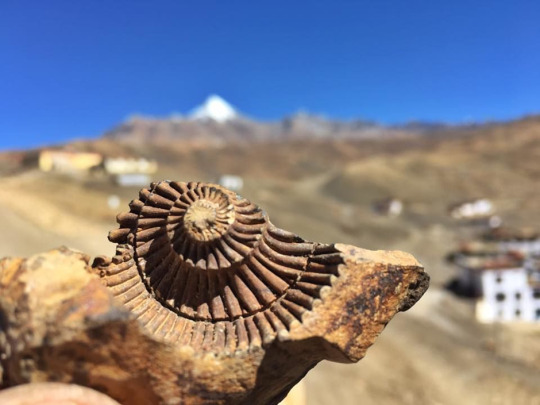
Nestled amidst the mighty Himalayan ranges, Spiti Valley stands as a geological and archaeological treasure trove waiting to be explored. Fossil hunting in Spiti Valley is a unique and thrilling adventure, offering enthusiasts the opportunity to unravel the mysteries of ancient life forms that once roamed this high-altitude desert. In this comprehensive exploration, we delve into the geological history of Spiti, the significance of fossil discoveries, the methods employed in fossil hunting, and the impact of these findings on our understanding of Earth's evolutionary past.
Fossil enthusiasts can engage in exciting expeditions, exploring remote areas of the valley to unearth fossilized treasures hidden within sedimentary rock layers. Spiti Valley bike trip can be an adventurous experience, which most young adults prefer to do. The beauty of Spiti Valley can be witnessed best on a bike trip.
There are more options to travel to Spiti Valley such as busses, trains, or private transportation.
Geological History of Spiti Valley:
Spiti Valley, situated in the Indian state of Himachal Pradesh, is characterized by its rugged terrain and extreme climatic conditions. The region's geological history dates back millions of years, with evidence of marine deposits, sedimentary rocks, and tectonic activities shaping the landscape. The valley was once submerged beneath the Tethys Sea, leaving behind a rich fossil record that serves as a time capsule of ancient life.
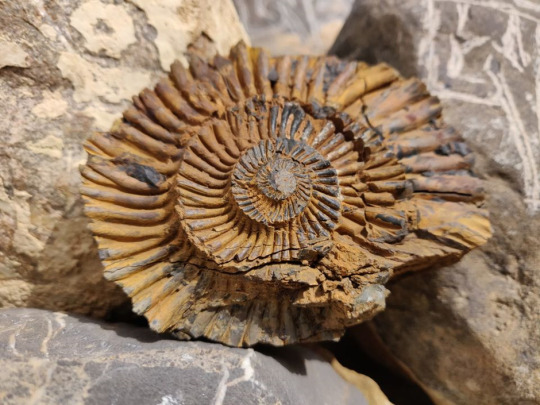
During the Paleozoic and Mesozoic eras, marine organisms such as trilobites, brachiopods, and ammonites thrived in the Tethys Sea. The gradual uplift of the Himalayas, driven by tectonic forces, led to the emergence of Spiti Valley as a high-altitude desert. As the sea retreated, it left behind layers of sedimentary rocks, preserving a diverse array of fossils that capture the evolution of life over millions of years.
Significance of Fossil Discoveries in Spiti:
Fossil hunting in Spiti Valley has garnered international attention due to the exceptional quality and diversity of fossils found in the region. The fossils provide crucial insights into the evolution of marine life during different geological epochs. Researchers have unearthed fossils of extinct marine reptiles, ancient fish species, and plant remains, painting a vivid picture of the ecosystems that once thrived in this now-arid landscape.
One of the most significant finds in Spiti is the discovery of marine reptile fossils, including ichthyosaurs and plesiosaurs. These creatures, resembling prehistoric dolphins and sea serpents, offer valuable information about the Mesozoic marine environment and the adaptation of life to changing conditions.
0 notes
Text
The Geological Wonder: Understanding the Origins and Characteristics of Sunshine Coast Sandstone
Introduction
Welcome to a comprehensive exploration of the geological marvel that is Sunshine Coast Sandstone. In this detailed analysis, we delve into the origins, unique characteristics, and environmental significance of this extraordinary natural formation.

Unraveling the Origins
Sunshine Coast Sandstone, a geological wonder, traces its roots back millions of years. Formed during the Mesozoic Era, the sandstone on the Sunshine Coast began its journey as sedimentary deposits in ancient oceans. Over time, geological forces acted upon these deposits, compressing and solidifying them into the majestic rock formations we witness today.
Composition and Distinctive Features
Mineral Composition
The primary constituents of Sunshine Coast Sandstone include quartz, feldspar, and lithic fragments. This unique blend results in a visually stunning array of colors, ranging from warm yellows to rich reds, contributing to the sandstone's aesthetic appeal.
Porosity and Durability
One of the defining features of this sandstone is its remarkable porosity, allowing it to absorb and release water efficiently. This characteristic plays a vital role in the ecosystem, supporting diverse plant life and aiding in groundwater recharge. Moreover, its inherent durability makes it a preferred choice in construction, adding both strength and aesthetic charm to architectural projects.
Geological Formations on the Sunshine Coast
Glass House Mountains
Prominent on the Sunshine Coast, the Glass House Mountains stand as a testament to the region's geological diversity. Composed largely of Sunshine Coast Sandstone, these peaks offer breathtaking panoramic views, attracting both nature enthusiasts and geologists alike.
Pumicestone Passage
The Pumicestone Passage, a tidal waterway flanked by the sandstone, provides a unique habitat for marine life. Its shores, shaped by the constant ebb and flow of tides, showcase the erosive power of Sunshine Coast Sandstone, creating intricate formations that are both scientifically fascinating and visually captivating.
Environmental Significance
Biodiversity Hotspot
Beyond its geological allure, the Sunshine Coast Sandstone plays a crucial role in fostering biodiversity. The porous nature of the rock facilitates the growth of native vegetation, creating a habitat for a diverse array of plant species. This, in turn, supports various fauna, making the sandstone region a biodiversity hotspot.
Conservation Efforts
Recognizing the ecological importance of the Sunshine Coast Sandstone, conservation efforts are underway to preserve and protect these formations. Local initiatives aim to strike a balance between human development and the conservation of this natural heritage, ensuring that future generations can continue to marvel at its beauty.
Conclusion
In conclusion, the Sunshine Coast Sandstone stands as a geological marvel with a rich history, distinctive features, and crucial environmental significance. Its role in shaping the landscape, supporting biodiversity, and contributing to architectural masterpieces makes it a subject of fascination for scientists, nature lovers, and architects alike.
1 note
·
View note
Photo
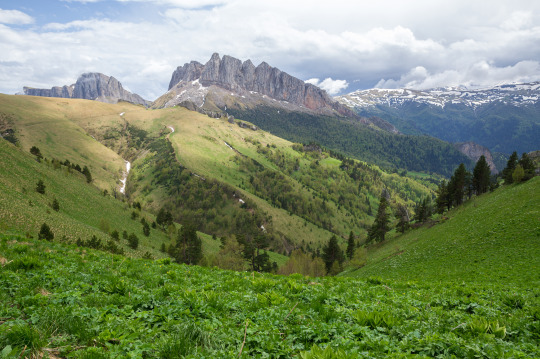
Wikipedia picture of the day on July 27, 2023: Acheshbok Massif and Shisha River headwaters, Adygea, Western Caucasus. The mountain landscape represents the Early Mesozoic evolution of the Western Caucasus. The prototype administrative entity of the Republic of Adygea was first established on July 27, 1922. https://ift.tt/uPw5fU1
0 notes
Photo

Wikipedia picture of the day on July 27, 2023: #Swiftunlock
Acheshbok Massif and Shisha River headwaters, Adygea, Western Caucasus. The mountain landscape represents the Early Mesozoic evolution of the Western Caucasus. The prototype administrative entity of the Republic of Adygea was first established on July 27, 1922.
more.
0 notes
Text
Work in Progress: Walking in the Chinle Formation
Work in Progress: Walking in the Chinle Formation.

View On WordPress
#adobe photoshop#ancient reptiles#arizona#artistatwork#Commissions Open#Concept Art#Digital Art#digital drawing#dinosaurs#Environment Art#Environment Design#Forrest Fire#landscape#landscape art#Mesozoic#Mesozoic era#national park#petrified forrest park#Triassic Period#Wacom Tablet#work in progress
1 note
·
View note
Photo

Wikipedia picture of the day on July 27, 2023:
Acheshbok Massif and Shisha River headwaters, Adygea, Western Caucasus. The mountain landscape represents the Early Mesozoic evolution of the Western Caucasus. The prototype administrative entity of the Republic of Adygea was first established on July 27, 1922.
Learn more.
0 notes
Photo
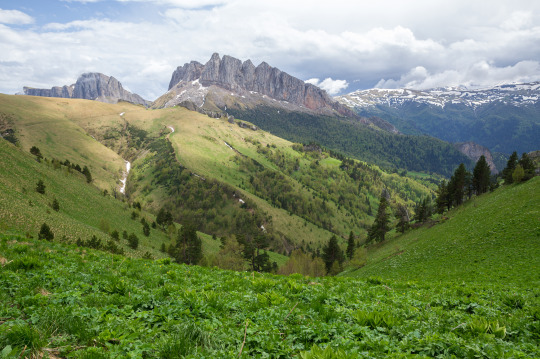
Wikipedia picture of the day on July 27, 2023:
Acheshbok Massif and Shisha River headwaters, Adygea, Western Caucasus. The mountain landscape represents the Early Mesozoic evolution of the Western Caucasus. The prototype administrative entity of the Republic of Adygea was first established on July 27, 1922.
Learn more.
0 notes
Photo

Wikipedia picture of the day on July 27, 2023:
Acheshbok Massif and Shisha River headwaters, Adygea, Western Caucasus. The mountain landscape represents the Early Mesozoic evolution of the Western Caucasus. The prototype administrative entity of the Republic of Adygea was first established on July 27, 1922.
Learn more.
0 notes